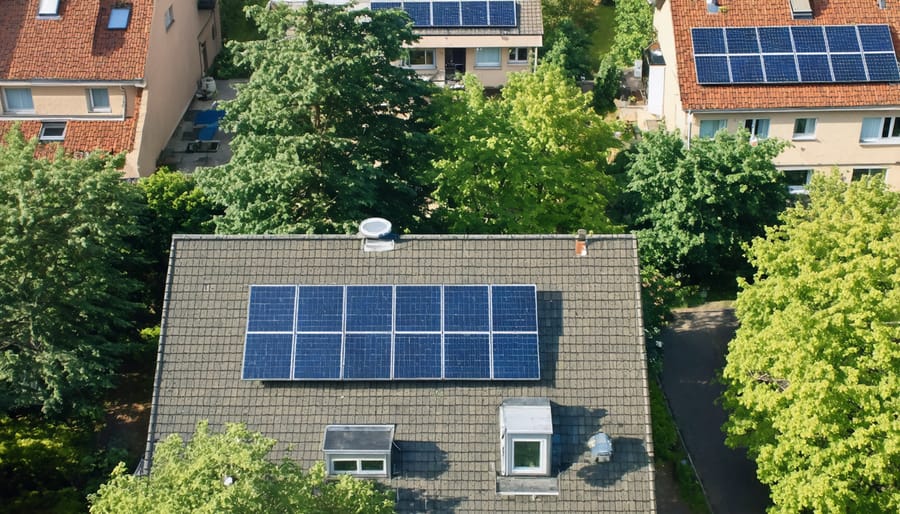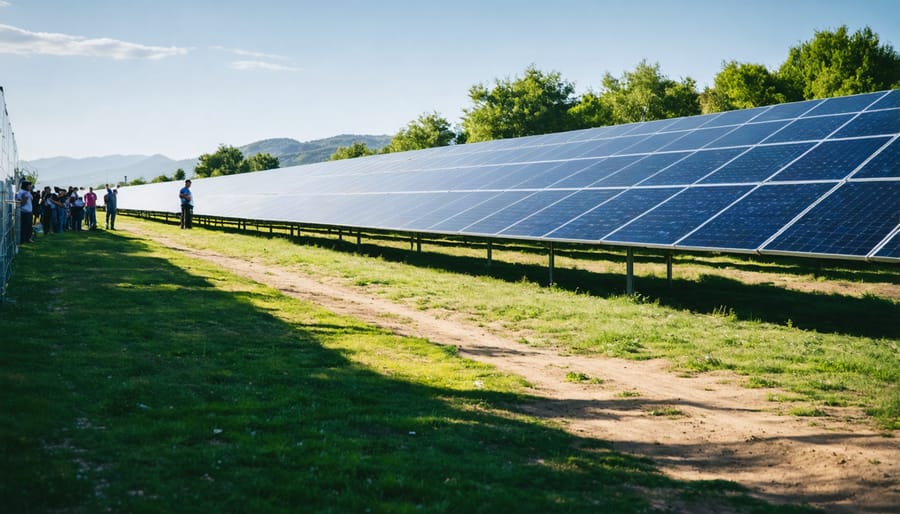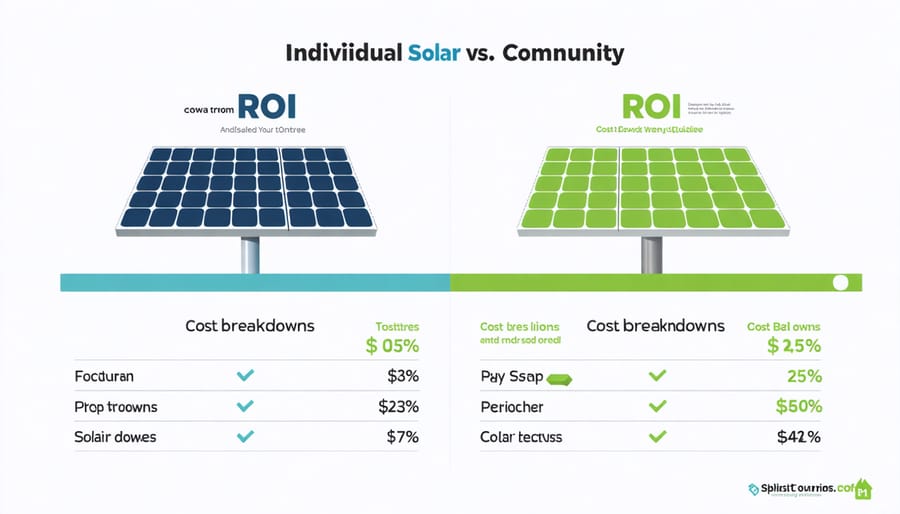Community Solar vs Home Solar: Which Path Leads to Greater Energy Independence?

As Europe accelerates its transition towards sustainable energy, two transformative solar power models are reshaping how communities access clean electricity: distributed generation and community solar. While both approaches champion renewable energy adoption, they offer distinctly different pathways to solar ownership and energy independence. Distributed generation empowers individual property owners to install their own solar systems, providing direct control over energy production and consumption. In contrast, community solar creates shared solar facilities that enable multiple participants to benefit from clean energy without requiring rooftop installations.
The choice between these models carries significant implications for energy democratization, grid resilience, and local economic development across European regions. With the EU’s ambitious renewable energy targets and growing public interest in sustainable solutions, understanding the nuances between distributed generation and community solar has become crucial for homeowners, businesses, and municipalities alike. These complementary approaches represent different facets of Europe’s energy transition, each offering unique advantages in terms of accessibility, scalability, and investment requirements.
This comprehensive comparison explores how both models operate within the European context, examining their respective benefits, challenges, and optimal use cases to help stakeholders make informed decisions about their solar energy journey.
Understanding Distributed Generation

Key Benefits of Individual Solar Installations
Individual solar installations offer compelling advantages that make them an attractive option for European property owners. The most significant benefit is direct energy control, allowing you to manage your electricity production and consumption with precision. You can monitor real-time performance, adjust usage patterns, and optimise your energy efficiency according to your specific needs.
Installing solar panels on your property typically increases its market value substantially. Studies across European markets show that homes with solar installations command premium prices, with value increases ranging from 3% to 8%. This enhancement represents a tangible return on investment beyond energy savings.
Personal energy independence is another crucial advantage. By generating your own electricity, you reduce reliance on the traditional power grid and shield yourself from rising energy costs. During daylight hours, your system can produce most or all of your required electricity, while excess energy can be stored in batteries for evening use or fed back into the grid for compensation through feed-in tariffs.
The system’s scalability allows for future expansion as your energy needs grow. Whether you start with a modest installation or opt for a comprehensive system, you maintain complete control over your energy infrastructure. This flexibility, combined with modern smart home integration capabilities, enables you to create a truly personalised energy management solution that aligns perfectly with your household’s or business’s consumption patterns.
Technical and Financial Considerations
The installation requirements and associated costs vary significantly between distributed generation and community solar projects. For distributed generation, property owners must ensure their building structure can support advanced solar panel technology, often requiring professional structural assessment and potential reinforcement. Initial investments typically range from €5,000 to €20,000 for residential installations, with commercial systems costing substantially more.
Maintenance responsibilities fall entirely on the property owner in distributed generation, including regular cleaning, performance monitoring, and occasional repairs. These ongoing costs typically amount to 1-2% of the initial investment annually.
Community solar, conversely, requires no individual installation or maintenance responsibilities. Participants pay a subscription fee or purchase a share in the project, usually starting from €500-€3,000. The project developer handles all technical aspects, including installation, maintenance, and system optimization. This significantly reduces individual risk and eliminates the need for property modifications.
Both options benefit from European Union incentives and subsidies, though specific support mechanisms vary by country. Community solar projects often achieve better economies of scale, resulting in lower per-watt costs compared to individual installations. However, distributed generation offers greater control over system specifications and potential integration with home energy management systems.
The Rise of Community Solar Projects
How Community Solar Works
Community solar operates through shared solar installations that serve multiple participants within a local area. These installations, typically ground-mounted or situated on large commercial rooftops, generate clean energy that’s distributed among subscribers through the existing power grid.
Participation models in community solar projects vary across European regions. The most common approach involves a subscription-based system where participants purchase or lease a portion of the solar array’s output. This arrangement allows residents, businesses, and organisations to benefit from solar energy without installing panels on their own properties.
The energy distribution process is straightforward and efficient. When the solar installation generates electricity, it feeds directly into the local power grid. Subscribers receive credits on their electricity bills proportional to their share of the project’s output. This virtual net metering system ensures fair distribution of benefits among all participants.
Project developers typically handle the installation, maintenance, and administrative aspects, while local utilities manage the power distribution and billing credits. Many European community solar initiatives also incorporate smart grid technologies to optimise energy distribution and consumption patterns.
Subscribers can often monitor their energy production and savings through digital platforms, providing transparency and control over their renewable energy investment. This system makes solar energy accessible to a broader range of participants, including renters, apartment dwellers, and those with unsuitable roof conditions.

Community Benefits and Challenges
Both distributed generation and community solar projects offer distinct benefits and challenges for participants. Community solar initiatives are revolutionizing local energy production by making solar power accessible to a broader population through shared costs and reduced individual investment requirements. Participants typically save 10-15% on their energy bills while avoiding installation and maintenance responsibilities.
However, community projects require careful coordination among multiple stakeholders, potentially leading to longer decision-making processes. Project management complexity increases with the number of participants, necessitating clear governance structures and professional administration.
Distributed generation offers greater individual control and potentially higher returns on investment, but requires significant upfront capital and ongoing maintenance responsibility. Property owners must also navigate local planning permissions and grid connection requirements independently.
Both approaches benefit from economies of scale, though in different ways. Community solar achieves this through bulk purchasing and shared infrastructure, while distributed generation may leverage volume discounts through installer networks. Professional support systems are crucial for both models, with community solar requiring expertise in participant management and distributed generation needing technical maintenance capabilities.
The choice between these models often depends on property ownership status, available capital, and desired level of involvement in system management.
Making the Right Choice for Your Situation
Cost Analysis and ROI Comparison
When evaluating solar project financing options, understanding the cost implications and return on investment (ROI) for both distributed generation and community solar is crucial. Initial installation costs for distributed generation typically range from €5,000 to €15,000 for residential systems and €50,000 to €500,000 for commercial installations, depending on system size and complexity. These costs include equipment, installation, and necessary permits.
Community solar, conversely, often requires lower upfront investment, with subscription fees ranging from €500 to €3,000. Participants purchase or lease solar shares, spreading costs across multiple stakeholders. Monthly savings typically range from 10% to 20% on electricity bills.
For distributed generation, ROI periods in Europe average 6-8 years, with systems generating returns through direct energy savings and potential feed-in tariffs. Annual maintenance costs average 1% of the initial investment. Solar panel efficiency degradation (0.5% annually) is factored into long-term returns, with systems maintaining 80-85% efficiency after 25 years.
Community solar projects generally show ROI periods of 7-10 years. While slightly longer than distributed generation, they offer lower risk and minimal maintenance responsibilities. Subscribers benefit from economies of scale, with larger installations reducing per-unit energy costs by 15-25% compared to individual systems.
Additional financial considerations include:
– Tax incentives and EU-specific grants
– Grid connection fees
– Insurance costs
– Potential property value increase (3-4% for distributed generation)
– Energy storage integration costs
– Administrative fees for community solar participation
When calculating total costs, factor in regional electricity rates, local solar irradiance, and available government incentives. Both options demonstrate positive financial returns, with choice depending on individual circumstances, investment capacity, and long-term energy goals.

Location and Property Considerations
The physical location of your property plays a crucial role in determining whether distributed generation or community solar is the more suitable option. For distributed generation, your property needs adequate roof space or ground area with optimal sun exposure. In Europe, this typically means a south-facing orientation with minimal shading from nearby buildings, trees, or other obstacles. The structural integrity of your roof must also be sufficient to support solar panel installation.
Community solar, conversely, offers flexibility regarding property constraints. Since the solar installation is located off-site, you don’t need to worry about your property’s physical characteristics. This makes it particularly attractive for apartment dwellers, historic buildings with preservation requirements, or properties with unfavorable solar conditions.
Climate and local weather patterns also influence this decision. While both options operate effectively across Europe, regions with higher solar irradiance, such as Southern Europe, might favor distributed generation due to maximised energy production. Northern European locations, with more variable weather patterns, might find community solar more advantageous due to the economies of scale and optimised site selection.
Urban versus rural location is another key consideration. Dense urban areas often face space limitations and complex permitting processes, making community solar more practical. Rural properties typically have fewer restrictions and more installation options for distributed generation.
Local grid infrastructure capabilities should also factor into your decision. Some areas may have grid capacity limitations that affect distributed generation installations, while community solar projects are typically planned with existing grid infrastructure in mind.
Long-term Maintenance and Support
The maintenance requirements and support systems for distributed generation and community solar projects differ significantly in scope and responsibility. In distributed generation, individual system owners are primarily responsible for maintaining their installations, which typically includes regular panel cleaning, inverter checks, and performance monitoring. European homeowners can access comprehensive maintenance services through certified local installers and manufacturers’ service networks, ensuring optimal system performance throughout its lifecycle.
Community solar installations benefit from professional maintenance teams who handle all technical aspects, reducing individual responsibility. Participants simply subscribe to the service while experienced technicians manage routine inspections, repairs, and system optimisation. This centralised approach often results in more consistent maintenance schedules and faster response times to technical issues.
Both models are supported by robust European warranty systems and professional service networks. Distributed generation owners can rely on manufacturer warranties typically spanning 20-25 years for panels and 10-12 years for inverters. Many European installers offer additional service packages that include regular maintenance checks and performance guarantees.
Community solar projects often incorporate maintenance costs into their subscription fees, providing participants with worry-free operation. These installations usually maintain service agreements with equipment manufacturers and local maintenance providers, ensuring rapid response to any technical issues.
Digital monitoring systems play a crucial role in both scenarios, enabling real-time performance tracking and early problem detection. Modern solar installations in Europe increasingly utilise smart monitoring platforms that alert maintenance teams to potential issues before they affect system performance, contributing to longer system lifespans and improved energy yields.
The choice between distributed generation and community solar ultimately depends on your specific circumstances, including property ownership, available space, investment capacity, and energy consumption patterns. Both approaches offer viable paths towards sustainable energy adoption, with distributed generation providing greater autonomy and control, while community solar enables broader participation and reduced individual responsibility.
For European property owners with suitable roof space and the means to invest, distributed generation offers an excellent opportunity to take direct control of your energy production. However, if you live in an apartment, have limited installation options, or prefer a more flexible commitment, community solar presents an accessible alternative that still contributes to the renewable energy transition.
Consider starting your solar journey by conducting a thorough assessment of your energy needs and consulting with local solar experts who can evaluate your specific situation. Many European regions offer comprehensive support programs, including technical guidance, financial incentives, and regulatory assistance to help you make an informed decision.
Whether you choose distributed generation or community solar, you’ll be joining the growing movement towards sustainable energy independence. The key is to take that first step – research your options, connect with local solar communities, and engage with experienced providers who can guide you through the process. Your decision today will contribute to a more sustainable energy future for Europe.
Leave a Reply